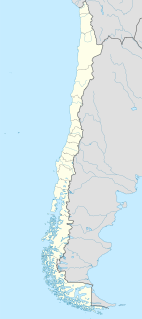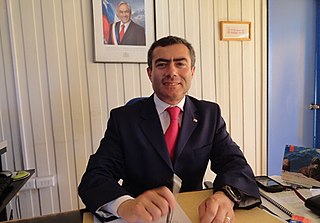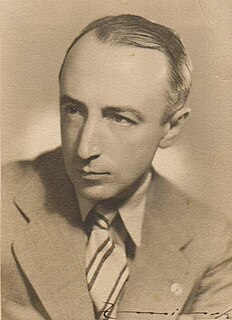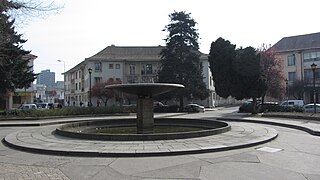
Juan Antonio Ríos Morales was a Chilean political figure. He was President of Chile from 1942 to 1946, during the height of World War II. He died in office.

Pedro Aguirre Cerda was a Chilean political figure. A member of the Radical Party, he was chosen as the Popular Front's candidate for the 1938 presidential election, and was elected. He governed Chile until his death in 1941. Pedro Aguirre Cerda was of Basque descent.

Pedro Aguirre Cerda is a commune of Chile located in Santiago Province, Santiago Metropolitan Region. It is named after President Pedro Aguirre Cerda.

Instituto Nacional General José Miguel Carrera, often shortened to Instituto Nacional, is an all-male public school in downtown Santiago, Chile which teaches students between 7th and 12th grade.

Alfredo Duhalde Vásquez was a Chilean politician who served twice as provisional president in 1946.

The Radical Party was a Chilean political party. It was formed in 1863 in Copiapó by a split in the Liberal Party. Not coincidentally, it was formed shortly after the organization of the Grand Lodge of Chile, and it has maintained a close relationship with Chilean Freemasonry throughout its life. As such, it represented the anticlericalist position in Chilean politics, and was instrumental in producing the "theological reforms" in Chilean law in the early 1880s. These laws removed the cemeteries from the control of the Roman Catholic Church, established a civil registry of births and death in place of the previous recordkeeping of the church, and established a civil law of matrimony, which removed the determination of validity of marriages from the church. Prior to these laws, it was impossible for non-Catholics to contract marriage in Chile, and meant that any children they produced were illegitimate. Non-Catholics had also been barred from burial in Catholic cemeteries, which were virtually the only cemeteries in the country; instead, non-Catholics were buried in the beaches, and even on the Santa Lucia Hill in Santiago, which, in the 19th century, functioned as Santiago's dump.
The Popular Front in Chile was an electoral and political left-wing coalition from 1937 to February 1941, during the Presidential Republic Era (1924–1973). It gathered together the Radical Party, the Socialist Party, the Communist Party, the Democratic Party and the Radical Socialist Party, as well as organizations such as the Confederación de Trabajadores de Chile (CTCH) trade-union, the Mapuche movement which unified itself in the Frente Único Araucano, and the feminist Movimiento Pro-Emancipación de las Mujeres de Chile (MEMCh).

Juana Rosa Aguirre Luco was First Lady of Chile and the wife of President Pedro Aguirre Cerda, who was also her cousin.

La Cruz is a city and commune in the Quillota Province of central Chile's fifth region of Valparaíso.

Julio Diego Ibarra Maldonado is a Chilean politician. Ibarra was the Governor of Cardenal Caro Province since he was appointed by President of Chile Sebastián Piñera on March 16, 2010. He left office on March 12, 2014.

Luciano Kulczewski was a Chilean architect of the 20th century.
Liceo Industrial Presidente Pedro Aguirre Cerda is a Chilean high school located in Rancagua, Cachapoal Province, Chile.
Liceo Técnico Santa Cruz de Triana is a Chilean high school located in Rancagua, Cachapoal Province, Chile.

Santiago Metro Line 6 is a line on the Santiago Metro, Santiago, Chile. It connects the commune of Cerrillos, in the south west of the city, with Providencia in the east of the city, where most economic activity is concentrated. It has 10 new stations on 15.3 km of track.

Plaza Perú is a square in the city of Concepción, Chile. It is situated in the University District in front of the main entrance of the Ciudad Universitaria de Concepción, by the Arco Universidad de Concepción and adjacent to the Casa del Arte. Built in 1942, there are several historic buildings surrounding the square, which were built in the 1940s. The plaza is known for being a gathering of students at the University of Concepción and youth in general.
The following lists events that happened during 1939 in Chile.
Lycée Français International de Tenerife "Jules Verne" is a French international school in Santa Cruz de Tenerife, Spain. A part of the Mission Laïque Française (MLF) network, it serves maternelle (preschool) through lycée. It offers the "bachibac".

President Pedro Aguirre Cerda Station was a Chilean Antarctic base, located at Pendulum Cove in Deception Island in the South Shetland Islands, inaugurated in 1955. The same year, the Falkland Islands and Dependencies Aerial Survey Expedition was established at Deception Island to help the survey of the Antarctic Peninsula, operating aircraft from Hunting Aerosurveys Ltd.













